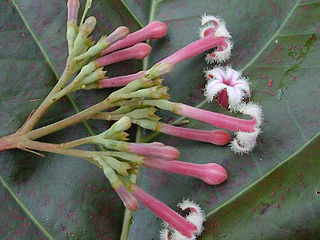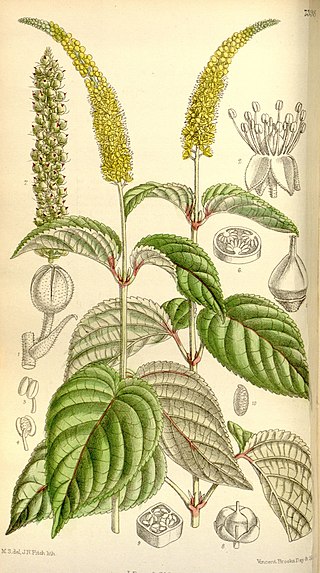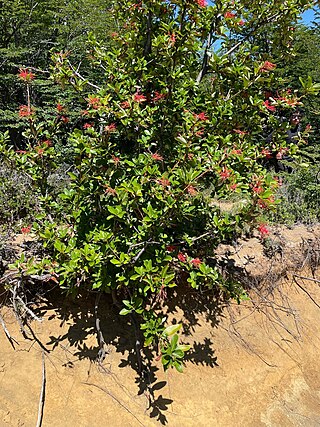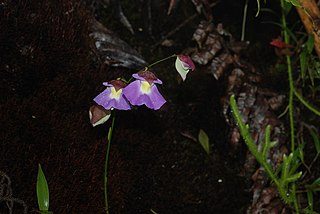
Cinchona is a genus of flowering plants in the family Rubiaceae containing at least 23 species of trees and shrubs. All are native to the tropical Andean forests of western South America. A few species are reportedly naturalized in Central America, Jamaica, French Polynesia, Sulawesi, Saint Helena in the South Atlantic, and São Tomé and Príncipe off the coast of tropical Africa, and others have been cultivated in India and Java, where they have formed hybrids.

Abatia is a genus of about ten species of Central and South American trees in the family Salicaceae. Previously, it was treated in the family Flacourtiaceae, or tribe Abatieae of the family Passifloraceae or Samydaceae by G. Bentham & J.D. Hooker and Hutchinson.

Alzatea verticillata is a small flowering tree, native to the Neotropics. It inhabits moist submontane forests from Costa Rica and Panama in Central America south to Peru and Bolivia in tropical South America. It is the sole species of genus Alzatea and family Alzateaceae.

The Polemoniaceae are a family of flowering plants consisting of about 27 genera with 270–400 species of annuals and perennials native to the Northern Hemisphere and South America, with the center of diversity in western North America.

Azara is a genus of eleven species of flowering plants in the family Salicaceae. They are native to temperate to subtropical regions of South America, from southern Brazil and Bolivia to southern Argentina and Chile. They are most often found at woodland margins and lakesides. Azara was formerly classed in the family Flacourtiaceae.

Embothrium is a genus of two to eight species in the plant family Proteaceae, native to southern South America, in Chile and adjacent western Argentina; the genus occurs as far south as Tierra del Fuego. Common names include Chilean firebush in English, notro in Argentina, ciruelillo, fosforito or notro chileno in Chilean Spanish.

Weinmannia is a genus of trees and shrubs in the family Cunoniaceae. It contains 90 species, which range from Mexico through Central and South America including the Caribbean, and to the Mascarene Islands in the western Indian Ocean. It is absent from mainland Africa and Australia, but some fossils have been attributed to Weinmannia in Australia.

Iriartea is a genus in the palm family Arecaceae. It is native to Central and South America. The best-known species – and probably the only one – is Iriartea deltoidea, which is found from Nicaragua, south into Bolivia and a great portion of Western Amazonian basin. It is the most common tree in many forests in which it occurs.

Hipólito Ruiz López, or Hipólito Ruiz, was a Spanish botanist known for researching the floras of Peru and Chile during an expedition under Carlos III from 1777 to 1788. During the reign of Carlos III, three major botanical expeditions were sent to the New World; Ruiz and José Antonio Pavón Jiménez were the botanists for the first of these expeditions, to Peru and Chile.

Sanchezia is a genus of the plant family Acanthaceae. It contains 45 species. Members of this genus are shrubs, rarely small trees or herbs, occurring in the lowlands of tropical South and Central America. A close relative is Suessenguthia, which looks quite similar.

Cavanillesia is a genus of trees in the family Malvaceae. It is native to Panama and tropical South America.

Guatteria is a genus of flowering plants in the family Annonaceae. It is the largest genus in the family in South America, and the dominant genus in mature forest. The fruits are berries, borne in clusters on short stalks.

Utricularia unifolia is a species of perennial, medium-sized carnivorous plant that belongs to the family Lentibulariaceae. U. unifolia is native to Central America and western South America. It was originally published and described by Hipólito Ruiz López and José Antonio Pavón Jiménez in 1797 and later considered a synonym of Utricularia alpina until Peter Taylor's 1989 monograph on the genus where he restored the species as distinct from U. alpina. It grows as a terrestrial or epiphytic plant on moss-covered trees, rocks, or banks in cloud forests at altitudes between 2,000 m (6,562 ft) and 3,000 m (9,843 ft). U. unifolia usually produces only one leaf, which is where the species epithet "unifolia" is derived from.

Porlieria is a genus of flowering plants in the caltrop family, Zygophyllaceae. Species within this genus are shrubs or small trees of dry subtropical regions. The generic name honours Spanish ambassador Don Antonio Porlier de Baxamar.

Clinanthus is a genus of bulbous plants in the family Amaryllidaceae. It is found in western South America, including Ecuador, Peru, Bolivia, north Chile and north west Argentina.

Gaiadendron is a genus of parasitic shrubs or trees in the family Loranthaceae. It solely comprises the species Gaiadendron punctatum, which is found in North and South America.

Jaltomata is a genus of plants in the family Solanaceae. According to molecular phylogenies, Jaltomata is the sister genus to Solanum, which includes tomato, potato, and eggplant. Jaltomata has a neotropical distribution, in that species occur from the United States southwest through Latin America, and into the Andean region of South America. Species encompass a wide range of vegetative and reproductive trait variation, including growth habit, floral size, shape and color, as well as fruit size and color. The fruits of some of the species are eaten by humans in Latin and South America. Depending on the species, fruits may be red, green, orange, or dark purple.

Mesechites is a genus of plants in the family Apocynaceae first described as a genus in 1860. It is native to Mexico, Central America, South America, and the West Indies.
- Mesechites acuminatus Müll.Arg. - Peru
- Mesechites angustifolius(Poir.) Miers - Hispaniola
- Mesechites citrifolius(Kunth) Woodson - Colombia
- Mesechites mansoanus(A.DC.) Woodson - Paraguay, Brazil
- Mesechites minimus(Britton & P.Wilson) Woodson - Cuba
- Mesechites repens(Jacq.) Miers - Hispaniola, Navassa Island, Jamaica
- Mesechites roseus(A.DC.) Miers - Cuba
- Mesechites trifidus(Jacq.) Müll.Arg. - widespread from Tamaulipas in NE Mexico south to Paraguay + N Argentina
- Mesechites andrieuxii(Müll.Arg.) Miers = Mandevilla convolvulacea(A.DC.) Hemsl.
- Mesechites angustatusMiers = Mandevilla benthamii(A.DC.) K.Schum.
- Mesechites brownei(A.DC.) Miers = Mandevilla torosa(Jacq.) Woodson
- Mesechites dichotomus(Kunth) Miers = Laubertia boissieriA.DC.
- Mesechites guayaquilensisMiers = Mandevilla subsagittata(Ruiz & Pav.) Woodson
- Mesechites guianensis(A.DC.) Miers = Mandevilla rugellosa(Rich.) L.Allorge
- Mesechites hastatusMiers = Mandevilla subsagittata(Ruiz & Pav.) Woodson
- Mesechites hirtellulusMiers = Mandevilla oaxacana(A.DC.) Hemsl.
- Mesechites hirtellus(Kunth) Miers = Mandevilla subsagittata(Ruiz & Pav.) Woodson
- Mesechites jasminiflorus(M.Martens & Galeotti) Miers = Mandevilla subsagittata(Ruiz & Pav.) Woodson
- Mesechites lanceolatus(R.Br.) Miers = Parsonsia lanceolataR.Br.
- Mesechites oaxacanus(A.DC.) Miers = Mandevilla oaxacana(A.DC.) Hemsl.
- Mesechites ovalis(Ruiz & Pav. ex Markgr.) Pichon = Allomarkgrafia ovalis(Ruiz & Pav. ex Markgr.) Woodson
- Mesechites plumeriiflorus(Woodson) Pichon = Allomarkgrafia plumeriifloraWoodson
- Mesechites siphiliticus(L.f.) Lemée = Tabernaemontana siphilitica(L.f.) Leeuwenb.
- Mesechites subcarnosus(Benth.) Miers = Mandevilla subcarnosa(Benth.) Woodson
- Mesechites sulphureus(Vell.) Müll.Arg. = Prestonia coalita(Vell.) Woodson
- Mesechites torulosus(L.) Miers =Mandevilla torosa(Jacq.) Woodson

Columellia is a group of plant species in the Columelliaceae described as a genus in 1794.
Godoya is a genus of trees in the family Ochnaceae. It is native to South America.


















